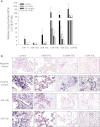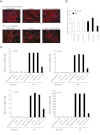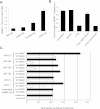Epigenetic regulation of miR-17~92 contributes to the pathogenesis of pulmonary fibrosis
- PMID: 23306545
- PMCID: PMC3603596
- DOI: 10.1164/rccm.201205-0888OC
Epigenetic regulation of miR-17~92 contributes to the pathogenesis of pulmonary fibrosis
Abstract
Rationale: Idiopathic pulmonary fibrosis (IPF) is a disease of progressive lung fibrosis with a high mortality rate. In organ repair and remodeling, epigenetic events are important. MicroRNAs (miRNAs) regulate gene expression post-transcriptionally and can target epigenetic molecules important in DNA methylation. The miR-17~92 miRNA cluster is critical for lung development and lung epithelial cell homeostasis and is predicted to target fibrotic genes and DNA methyltransferase (DNMT)-1 expression.
Objectives: We investigated the miR-17~92 cluster expression and its role in regulating DNA methylation events in IPF lung tissue.
Methods: Expression and DNA methylation patterns of miR-17~92 were determined in human IPF lung tissue and fibroblasts and fibrotic mouse lung tissue. The relationship between the miR-17~92 cluster and DNMT-1 expression was examined in vitro. Using a murine model of pulmonary fibrosis, we examined the therapeutic potential of the demethylating agent, 5'-aza-2'-deoxycytidine.
Measurements and main results: Compared with control samples, miR-17~92 expression was reduced in lung biopsies and lung fibroblasts from patients with IPF, whereas DNMT-1 expression and methylation of the miR-17~92 promoter was increased. Several miRNAs from the miR-17~92 cluster targeted DNMT-1 expression resulting in a negative feedback loop. Similarly, miR-17~92 expression was reduced in the lungs of bleomycin-treated mice. Treatment with 5'-aza-2'-deoxycytidine in a murine bleomycin-induced pulmonary fibrosis model reduced fibrotic gene and DNMT-1 expression, enhanced miR-17~92 cluster expression, and attenuated pulmonary fibrosis.
Conclusions: This study provides insight into the pathobiology of IPF and identifies a novel epigenetic feedback loop between miR-17~92 and DNMT-1 in lung fibrosis.
Figures






Comment in
-
The promise of epigenetic therapies in treatment of idiopathic pulmonary fibrosis.Am J Respir Crit Care Med. 2013 Feb 15;187(4):336-8. doi: 10.1164/rccm.201212-2272ED. Am J Respir Crit Care Med. 2013. PMID: 23418324 No abstract available.
-
Micro RNAs: the future of idiopathic pulmonary fibrosis therapy.Cell Biochem Biophys. 2015 Jan;71(1):509-11. doi: 10.1007/s12013-014-0217-9. Cell Biochem Biophys. 2015. PMID: 25164114 Free PMC article. No abstract available.
Similar articles
-
miR-21 mediates fibrogenic activation of pulmonary fibroblasts and lung fibrosis.J Exp Med. 2010 Aug 2;207(8):1589-97. doi: 10.1084/jem.20100035. Epub 2010 Jul 19. J Exp Med. 2010. PMID: 20643828 Free PMC article.
-
Inhibition of DNA methylation de-represses peroxisome proliferator-activated receptor-γ and attenuates pulmonary fibrosis.Br J Pharmacol. 2022 Apr;179(7):1304-1318. doi: 10.1111/bph.15655. Epub 2022 Jan 13. Br J Pharmacol. 2022. PMID: 34378791
-
Curcumin regulates pulmonary extracellular matrix remodeling and mitochondrial function to attenuate pulmonary fibrosis by regulating the miR-29a-3p/DNMT3A axis.Biomed Pharmacother. 2024 May;174:116572. doi: 10.1016/j.biopha.2024.116572. Epub 2024 Apr 15. Biomed Pharmacother. 2024. PMID: 38626519
-
MicroRNAs in idiopathic pulmonary fibrosis.Transl Res. 2011 Apr;157(4):191-9. doi: 10.1016/j.trsl.2011.01.012. Epub 2011 Feb 4. Transl Res. 2011. PMID: 21420029 Review.
-
Epigenomics of idiopathic pulmonary fibrosis.Epigenomics. 2012 Apr;4(2):195-203. doi: 10.2217/epi.12.10. Epigenomics. 2012. PMID: 22449190 Free PMC article. Review.
Cited by
-
Elevated Mirc1/Mir17-92 cluster expression negatively regulates autophagy and CFTR (cystic fibrosis transmembrane conductance regulator) function in CF macrophages.Autophagy. 2016 Nov;12(11):2026-2037. doi: 10.1080/15548627.2016.1217370. Autophagy. 2016. PMID: 27541364 Free PMC article.
-
Construction of a TFs-miRNA-mRNA network related to idiopathic pulmonary fibrosis.Ann Transl Med. 2023 Jan 31;11(2):78. doi: 10.21037/atm-22-6161. Ann Transl Med. 2023. PMID: 36819574 Free PMC article.
-
Role of endothelial cells in pulmonary fibrosis via SREBP2 activation.JCI Insight. 2021 Nov 22;6(22):e125635. doi: 10.1172/jci.insight.125635. JCI Insight. 2021. PMID: 34806652 Free PMC article.
-
Synergistic MicroRNA Therapy in Liver Fibrotic Rat Using MRI-Visible Nanocarrier Targeting Hepatic Stellate Cells.Adv Sci (Weinh). 2019 Jan 15;6(5):1801809. doi: 10.1002/advs.201801809. eCollection 2019 Mar 6. Adv Sci (Weinh). 2019. PMID: 30886803 Free PMC article.
-
Epigenetic Changes and Functions in Pneumoconiosis.Oxid Med Cell Longev. 2022 Jan 20;2022:2523066. doi: 10.1155/2022/2523066. eCollection 2022. Oxid Med Cell Longev. 2022. PMID: 35096264 Free PMC article. Review.
References
-
- Ley B, Collard HR, King TE., Jr Clinical course and prediction of survival in idiopathic pulmonary fibrosis. Am J Respir Crit Care Med 2011;183:431–440 - PubMed
-
- Magro CM, Waldman WJ, Knight DA, Allen JN, Nadasdy T, Frambach GE, Ross P, Marsh CB. Idiopathic pulmonary fibrosis related to endothelial injury and antiendothelial cell antibodies. Hum Immunol 2006;67:284–297 - PubMed
-
- Maher TM, Wells AU, Laurent GJ. Idiopathic pulmonary fibrosis: multiple causes and multiple mechanisms? Eur Respir J 2007;30:835–839 - PubMed
Publication types
MeSH terms
Substances
Grants and funding
LinkOut - more resources
Full Text Sources
Other Literature Sources

